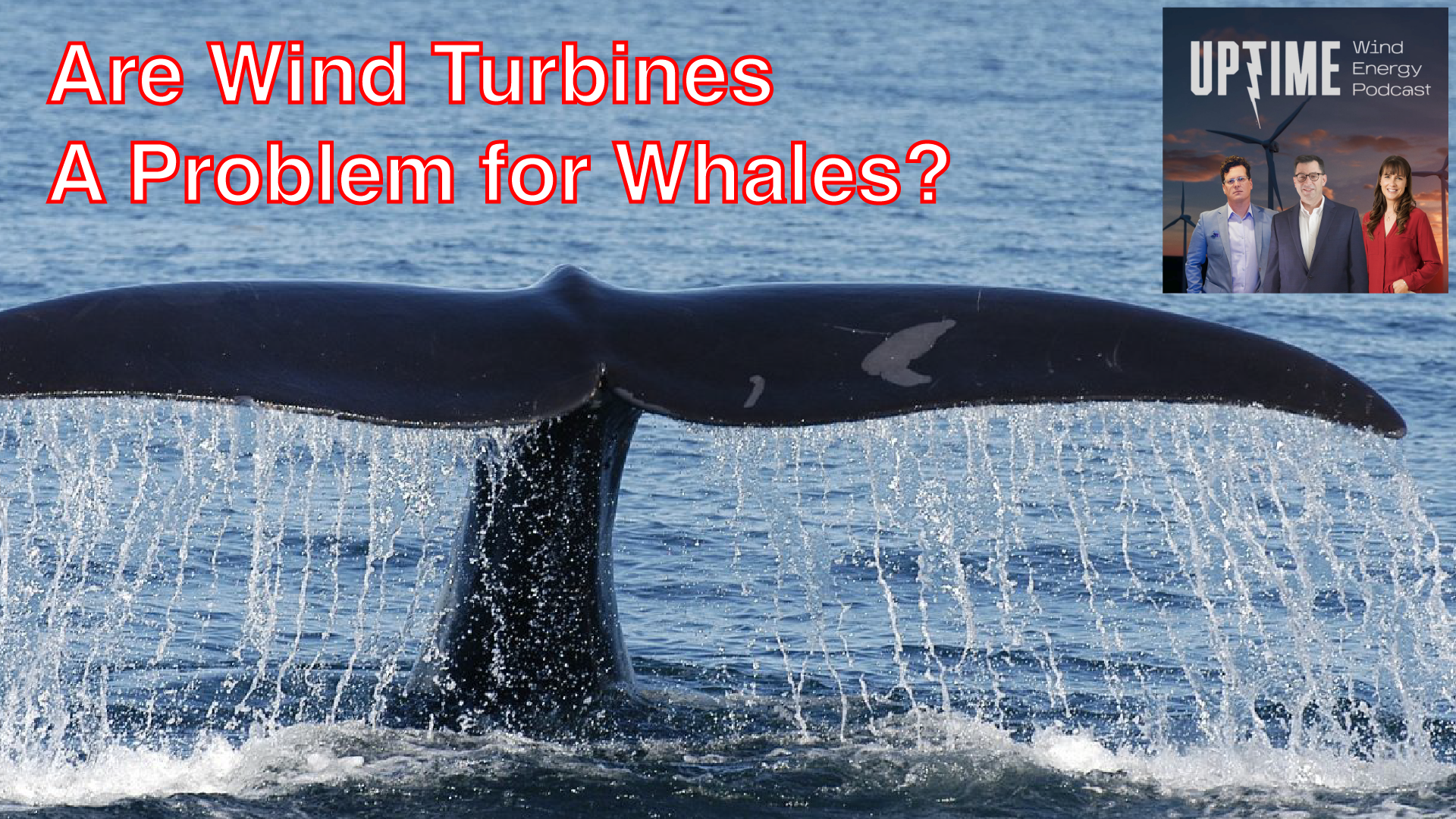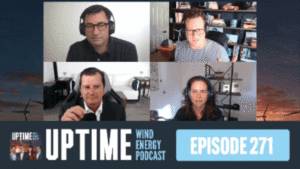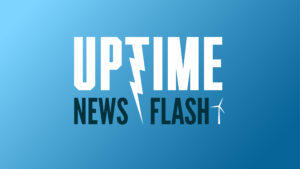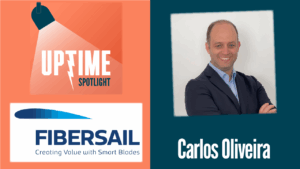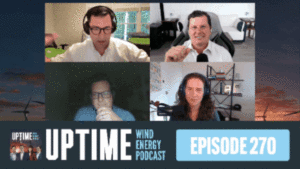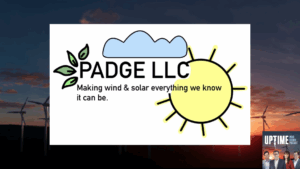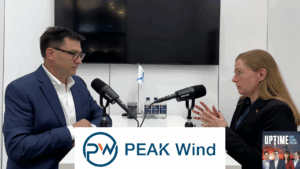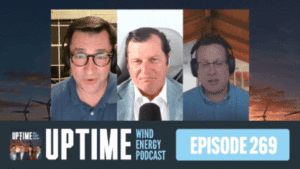Joel and Allen deep dive into WHALES along the US East Coast. Does sonar scans at offshore wind sites affect whale behavior? The East Coast has an uptick in ship traffic – does ship density push up whale incidents?
Visit Pardalote Consulting at https://www.pardaloteconsulting.com
Wind Power Lab – https://windpowerlab.com
Weather Guard Lightning Tech – www.weatherguardwind.com
Intelstor – https://www.intelstor.com
Podcast: Play in new window | Download
Sign up now for Uptime Tech News, our weekly email update on all things wind technology. This episode is sponsored by Weather Guard Lightning Tech. Learn more about Weather Guard’s StrikeTape Wind Turbine LPS retrofit. Follow the show on Facebook, YouTube, Twitter, Linkedin and visit Weather Guard on the web. And subscribe to Rosemary Barnes’ YouTube channel here. Have a question we can answer on the show? Email us!
153 Bonus
Allen Hall: Welcome to a bonus episode of the Uptime Podcast. I’m Allen Hall, president of Weather Guard Lightning Tech. And I’m here with Wind Power Lab’s Joel Saxum. And Joel and I have been looking at some of the whale incidents in the whale deaths that have been occurring on the northeast of the United States.
Allen Hall: And it’s raised a lot of issues along, along the East Coast, particularly with state and local governments that are concerned about these deaths, and there’s a lot of finger pointing going on right now, Joel, in, in regards to what is causing these well deaths and are offshore wind turbine operations.
Allen Hall: Particularly the sonar scans that are happening at the moment, harming the whales. And, and the whales they’re, they’re most interested in and are most concerned about are Right Whales because there’s about 350, 400 right whales left on the planet and we wanna make sure we continue to that species. So when we see a right whale end up on the shoreline, particularly down in New Jersey lately, it raises a lot of concern.
Joel Saxum: So, I mean, Allen we, you and I dug into a lot of the data and what the data tells us is that the majority, I think 58% we saw within US water were deaths of the right whales were due to fishing gear entanglement. And then the other large percentage of them was from vessel strikes. And there’s a small percentage of them that they’re, that, that are kind of mysteries.
Joel Saxum: We don’t, we don’t know. Right. But the majority of them is from, from fishing and it would be commercial fishing of course. And vessel strike. So they’ve put in, in 2008. A government agency, I can’t remember which one, put in a, a law and had certain areas that they blocked out basically during certain seasons, they know where they’re doing ca where calving is, they know where the whales are traveling to their feeding ground.
Joel Saxum: So they put in and a lot of ’em around ports. These, these areas where they have these 10 knot speed limits for any vessel that’s over 65 feet. And the idea is, is they, they found, they went through a bunch of studies and found that between 10 and 14 knots of speed is when the mortality rate of a collision increases.
Joel Saxum: So it went up once those 10 to 14 knot speeds and, and higher we’re, we’re breached. So they want to keep all those vessels under 10 knots. Smart move. Right. I think that’s great if you’re, Click on any pictures or websites and research. The same thing that Alan and I have been looking at for the last while do it after you’ve had a meal or something.
Joel Saxum: Cuz there’s some just not pretty pictures of Right whales on the, on the internet that have been hit by vessels. It’s a, it’s pretty, it’s a pretty sad site to see. So it’s not, not something we want to see, but what we’re, what we are seeing, and I say we as Alan and I looking through a lot of data here, so we looked at.
Joel Saxum: where we see all of the auctions happening for, for the wind off the East coast. We also looked@marinetraffic.com and some of the, the Marine, which tracks all the a i s system on commercial vessels and stuff around the world. And it gives you us maps of where all the traffic has been the, the ocean going traffic for the last few years.
Joel Saxum: So we looked at. We also looked at the maps of the whale deaths. We looked at the maps of where these 10 knot speed limits are. So more maps from, you know, Noah and the fisheries organizations about where cabin grounds are and where. These other items that have to do with right whales are, and, and what they’re, basically, how does it interact with what our society’s doing, society as a whole, right?
Joel Saxum: Where’s the shipping traffic, when, how’s it coming in? What is, where’s the fishing grounds look like? And we, we saw, we read an article actually that had a lot of right whale Inter, you know, negative right wheel interaction, some of them deaths up in the Gulf of St. Lawrence, up on Halifax and Quebec there.
Joel Saxum: Or not Halifax, but New Brunswick and Quebec because they’re swinging, the whales are swinging around there with water temperature changes for summer feeding grounds, and then all of a sudden they’re running into new hazards that they’re not used to, which is a lot of fishing nets up there. So we’re, what we’re trying to do here is tie together.
Joel Saxum: What is reality. And Alan, maybe you can share the, what, what’s, what’s kind of happening in the politics off the east coast there? That’s, that’s driven us to, to do this research. Yeah. Well,
Allen Hall: it’s mostly in New Jersey at the moment, but we’ve seen some activity in, off the coast of Massachusetts, and particularly in Nantucket.
Allen Hall: Right. Which used to be a, a, a big whaling island off the coast of Massachusetts. The group of New Jersey mayors recently are calling for an immediate moratorium on offshore wind energy development until. And state scientists can assure the public that ocean noise related to underwater CIB mapping, soil borings and other turbine construction activities poses no threat to whale.
Allen Hall: So the local governments are, are saying that the well deaths are a mystery and that the sonar scans around the wind turbine areas where wind turbines will be installed over the next several years are some. Damaging the whales, injuring the whales, causing the whales to be confused, and it is killing them.
Allen Hall: And, but that link is not made solid. All right. It’s a very murky link. Now, w there’s a couple of organizations, environmental organizations that are backing this claim. Cindy Zips executive director of the environmental organization, clean Ocean. Said in a statement earlier that the offshore wind companies are being allowed by federal regulators to disturb and.
Allen Hall: A certain number of whales and other marine animals during pre-construction and construction activity. And I, I, I haven’t seen any evidence of that so far. So it, it’s an interesting statement, but it’s not really backed up by evidence yet. And the Bureau of Ocean Energy Management center for Marine Acoustics.
Allen Hall: Responded to those claims and said, there’s just no sound evidence that high solution geophysical surveys which map the c bottom are causing any harm to marine mammals. So there’s a direct statement from, you know, federal agency saying, Hey, we looked into it and there’s not causing any problems. Now, Joel, you and I have been going back and forth looking at sort of more a study that happened from 2017 to about 2021 of documenting where these whales are dying at.
Allen Hall: Yeah, there are some whales dying off the east coast, but like you said, a lot of ’em are dying up in Canada in the summertime cause they’re getting tangled in nets. And the, the number of whales that have died based on just the tracking that has happened are in less than 10. Per year-ish. Right. And you, I think the biggest number I saw was like in the thirties, back in 2017.
Allen Hall: So the number of whales that have deceased this year is not necessarily way off the charts. It’s probably more in line with the normal range. If anything that could be normal, which is, this whole thing is weird because why? Why is the big fight against offshore wind when there’s really little to no activity happening?
Allen Hall: What’s, what’s, what’s the
Joel Saxum: push? Alan and I, of course, we’re not gonna, we’re not gonna. Sit here in front of you guys and tell you that we’re marine mammal scientists, or that we are super genius acoustic, subc, acoustic engineers or anything like that. But we, we do have some qualitative data and some basic knowledge around both of those things, right from our past and, and, and life travels.
Joel Saxum: So, you know, we’ve, we’ve walked through like, does it make sense? The act, we know the activities that are going on for site characterization, geophysical surveys, magnetometer surveys you know, the actual geotechnical drilling or core sampling that’s going on out there. And, and the, it’s minimal, really, like if you’re talking.
Joel Saxum: Magnetometer surveys, you’re cruising around, dragging a magnetometer at three, four knots geotechnical surveys, you’re stopped. Right? Like you’re, that vessel’s on dp and it’s, and it’s just doing one bore sample, like, okay, Viro core, you’re sending a little bit of vibration into the dirt. It’s, it’s not enough to harm a, you know, a, that, that acoustic emission might last a hundred or 200 meters in the.
Joel Saxum: You know, a near surface seismic refract that they might maybe be doing for looking for boulder clearance or trying to find where the, the seabed is, you know, the the bedrock is that’s a little bit more invasive, but still it’s, it’s not, it’s not seismic, you know, blasting off air cannons looking for oil and gas 5,000 meters deep.
Joel Saxum: So the, the level of impact to the local environment is, is, is really minimal, right? You, you, you might be able to, transmit that a, a kilometer or two through the water. But that’s just some, a little bit of acoustic noise, right? A vessel, a a, a sh an oil tanker, cruising through, churning up the water with its propellers and, and making waves and stuff is gonna make more acoustic noise in the water than that.
Joel Saxum: That simple activity is the other one there. That’s the wild card, right? Is Echo Sounders, right? So when you’re doing these geophysical surveys, you’re not just running a single beam echo sounder that shoots right down to the bottom and then shoots up to the boat. You’re, you’re using one that shoots a lot of beams out like a fan.
Joel Saxum: And, but, so if you’re in a hundred feet of water, that fan may be 300 feet wide under the boat. and you’re going back and forth in, in an area for a couple of months, scanning the whole sea floor, but still, you’re not, you’re not shooting that echo sounder out, perpendicular to the, to the sea floor to try and reach a kilometer or two and affecting all the area around you.
Joel Saxum: It’s pretty localized, so, , those are the activities that are going on right now. There’s no we’re not pounding monopiles out into the, into the, like, that’s not happening. The only thing that’s been installed is Block Island out there and you know, like one down in that in like West Virginia or Virginia, sorry, West Virginia is inshore, , Virginia.
Joel Saxum: And Block Island is jackets, right? So jackets, and I don’t know how they secure them to the bottom, but a lot of time a jacket is secured to the bottom by a suction. So you drop the jacket off the side of the boat. Once it hits the ground, you go down with, or the, the sea floor. You go down with an r o v, you hook up a zip pump to the legs, and you start pumping the water out.
Joel Saxum: When you pump the water out, pressure, differentiation sucks. The piles down into the mud. That’s not invasive, that’s not gonna cause harm to a whale, right? That’s that. That’s that hundred, 200 meter circle of that vessel operating and that r o v in the water. And then, and then you’re gone to the next one.
Joel Saxum: So there’s no. Bad extra acoustic activity or something super invasive that’s happening because of these wind farms. And that’s why we’re looking at this, these claims going like what? What could be underlying, what are, what is? What is a reason that it might be? And I can completely understand why someone might sit in an office not have a lot of information and say, man, we’ve been seeing a lot of whales wash up on the shore, so we’d like to have.
Joel Saxum: you know, a letter from whoever, whatever agency to say yes, we’ve, we’ve a hundred percent cleared this, you know, out of an abundance of caution, this isn’t gonna happen. But if you really wanted to stop all the right whales being injured, you’d have a, you’d, you know, you’d use the tagging system as you’re using now, and you’d have echolocation and you’d find out where they are currently.
Joel Saxum: And if there’s one cruising through a port, you’d shut all the port traffic down. The, the US government being capitalistic as a society isn’t gonna do that. Be most of these deaths have been proven to be from being struck by vessels. So if you shut all the vessel traffic down, that may solve to one study, 58% of the deaths of these whales.
Joel Saxum: But that also is gonna slow down the US economy, and that’s just not gonna happen.
Allen Hall: Right. And I, the wild car here is the amount of ship traffic on the east coast, right. Which is at, at record highs port of Houston, port of Savannah, South Carolina, and Port of Virginia. Each broke volume records in 2022 and shippers on the East Coast in general are seeing much more traffic because of the issue of the ports on the west coast.
Allen Hall: So instead of taking your cargo ship and, and hitting the port of Long Beach in California, And trying to use trains to get it to the east coast. What they’re doing now is they’re taking those ships to the east coast where the whales are. So you’re seeing an increased number of ships moving in these areas.
Allen Hall: And as Joel pointed out, there are restriction zones where the ships can only move at 10 knots, but they’re relatively small. And around those port entry areas like Crown Philadelphia New York Harbor. Once you get outside those immediate areas you can be whatever speed your ship is wanting to go.
Allen Hall: Well, there’s whales out there too. The whales aren’t just limited to those little inlets.
Joel Saxum: They don’t have a G P s heads up that says, oh, I gotta stay within this circle. They don’t have it. Right?
Allen Hall: So the increased amount of traffic in these areas is most likely causing some part of the problem. And, but weirdly enough, we’ve seen zero discussion about that in news articles and and maybe the scientists haven’t connected to the dots yet, or, or are still most likely still studying this.
Allen Hall: But there’s just no evidence that these sonar units which have been used worldwide and those whales all over the world have any issues with, with whales.
Joel Saxum: I mean, if you really, you know, if you wanna boil it down too, like the, the, those ports that the, all the shipping traffic is coming in are also the ports that have the 10 knot speed limit on it.
Joel Saxum: So it has been identified that these are right whale traffic areas and also high human traffic areas. also to note those ports are the same ones that have the exact same, sorry, I’m getting a little bit excited here. , but have the exact same site characterization surveys that are going on for these wind farms are regularly happening in those ports.
Joel Saxum: So the multi-beam echo sounder, the Cord decor, drilling, all that stuff to maintain an active port, you are consistently doing that. Every time there’s, every time you’re in a port and a port authority has someone come through and dredge something before they dredge it, there’s a multi-beam echo sounder survey done and after they dredge it, there’s another one done to update all the bathometric charts.
Joel Saxum: So all of the stuff that hap is happen. Out where empire wind and vineyard wind and blue wind and all these great wind energy locations are being, you know, explored for all of the things that are happening out there are also happening and have been happening for 50 years in those same port areas.
Joel Saxum: So to blame it on a multi-beam echo, sounder, scrambling the brains or the acoustic navigation system of a a right. is to say that it’s always been happening in the port itself already. S so, so I think what Alan and I, you know, we’ve, sometimes we like to take different opinions on things, but right now it, it really feels like to both of us that there’s a little bit of scapegoating going on here and it seems to be more of a political news game than it is an actual science.
Joel Saxum: Facts that are being put out to the
Allen Hall: public, right? It, it’s not particularly hard to find some of this data. Now, Joel and I have been looking at this over probably the last week, right? So there’s been a lot of different studies and some of these studies are hundreds of pages, so it’s a lot to sift through.
Allen Hall: But when you start connecting, looking at all the data that has been accumulated over the last 6, 7, 8 years, and then hearing the news stories, they just don’t. The, the research data is pointing in a completely different direction than what the news articles are, and it’s a little disappointed.
Allen Hall: Disappointing in that. You’d think that reporters would at least do a couple of Google searches and figure out what’s going on, or maybe call boham or, or maybe call Noah and get some feedback on what they think is happening because there are experts in this field that have been doing it a long time that probably have some really good insight
Joel Saxum: into it.
Joel Saxum: Yeah, I mean, and what that, what. that says to me is that the truth that would come from these people isn’t wanted to be put in the news, doesn’t get clicks. It’s, it’s this, this is to me is a classical case of macro versus micro nimbyism. I don’t wanna look at those wind farms. Please stop developing them.
Allen Hall: Right? And if you have a problem with a wind farm, great. You know, say your piece, go to the local township meetings, go to the city council meetings and say what you think. , that’s totally fine, but you can disagree with having with, with what’s happening with Wind farm. , but to assign it to the people working these ships, to assign it to malevolence, to you know, just, just care.
Allen Hall: I don’t even know how to put it. Like you just don’t care. I mean, that’s kind of what it gets down to. They’re saying that the people that work on these wind farms that are doing these surveys just don’t care about the sea life. I find that hard to believe. That’s just not the kind of people. That are on boats out there doing this work, particularly if you’re in the in renewable energy business, one of the reasons you’re doing it is because you care about the planet and you care about the animals and the creatures that live there to, to say you’re injuring.
Allen Hall: One of the rarest mammals on the planet just feels wrong. You know, you better back that up with some data if you’re gonna make that, make that claim. Yeah, totally
Joel Saxum: agreed. There’s, there’s something here that will come out in the wash eventually, I hope. But I do know there is a fantastic lady, c e o of a company.
Joel Saxum: and they have a, I cannot remember her name for the life of me right now. It just came back into my head. But sh her company was a part of doing some of the early surveys for some of these before you get to the site, characterization of the seat floor and everything you do met, met Ocean surveys, which is basically like you’re putting buoys out, you’re putting, you wanna know the salinity, the wave height, the temperatures, the currents, all these things of the, of, it’s called Met Ocean Studies to know what the, the water situation is gonna be before you even get.
Joel Saxum: the subsea because they’re, you know, you run into issues like a lot of people don’t know this, but in like the North Atlantic where a lot of wind farms are, there’s two and three knot subsea currents all day long. So it’s a difficult, it’s actually a difficult operation subsea to make sure that your cable lay is correct.
Joel Saxum: The rock dumps are on it, right? You don’t have scour around the base of your turbines all the time. You have to complete, you have to be inspecting that stuff all. But there’s a a lady that sh, I think they’re out of Vancouver. They have a company called, I wanna say it’s Open Ocean Robotics or something, but they had an a sv, which is an autonomous surface vehicle, and this thing can cruise.
Joel Saxum: I mean, they’re sending ’em off the beach and the things are going through like five meter surf waves flipping over, but it’s a little, it’s a little unmanned boat. But they were out there actually doing some of the original. Right whale surveys in the area as a part of the permitting process for a lot of these wind farms.
Joel Saxum: And for when the, when the, when the Bureau of Ocean Energy Management was setting all these areas up, they were like, we want to know what’s going out the right whales in these areas. And they were a part of doing this, and they had actual As, cause I was talking with her at a a, a symposium once and I was like, Hey, did you guys ever look it in some of this?
Joel Saxum: This was like a her name’s Julie Angus. I just found it again here. Open Ocean Robotics is the company. Really cool company, but they really, really interesting lady as well. She had one point in time, like went across the Pacific Ocean paddling by herself and yeah, she’s, she’s, she’s an impressive individual.
Joel Saxum: But they were a part of doing some right whale surveys in the area of all these wind farms on manned vessels. They had acoustic sensors on board listening for them as they were traveling through these areas. So the, there’s a, there’s a pretty high understanding of the travel corridors and activities of those, of those mammals it around these areas, and they’ve been cited in certain spots so that they don’t interfere with them.
Allen Hall: That’s just what we need, right? We need to have that data as we, and. Juror of Ocean Energy Management has seen that data. And I know in the research presentations at Northeastern University a couple of months ago, that’s one of the issues they were discussing was where the right whales were passed by some of these wind farms off the coast of Massachusetts and how do you handle the boat traffic back and forth?
Allen Hall: You had to be really careful at certain times a year. We need to be paying attention to that. It’s exactly right that the data is mostly there. and we’re gonna continue to gather that data because we’re all concerned about the right whale, and we’re trying to minimize really bad incidents. You know, these, these deaths that shouldn’t be happening necessarily.
Allen Hall: Obviously it’s gonna be accidents, things happen. But if we can reduce those, that’s important because the number of of calves born a year are somewhere between 10 and 20. So if you have 20 deaths in a year, That population will never grow. Right. And that’s the problem is that that population is kind of stagnant.
Allen Hall: So we need to get those calves to develop into full grown whales and have more calves, and we get that population back up. So these these, these deaths are really troubling and we need to work on it more. But I, I think at this point, Declaring that sonar scans of the ocean floor causing these deaths are just not correct.
Allen Hall: Right now. There’s just not enough data to point there.
Joel Saxum: It’s a little farfetched.
Allen Hall: Yeah, it’s, it’s a little, let’s say it’s impossible. It’s possible, but you better bring the data.
Joel Saxum: Yeah. Understand it as a, as a thing to bring up, as an abundance of caution, but bring this, bring the science that’s a hundred percent correct.



